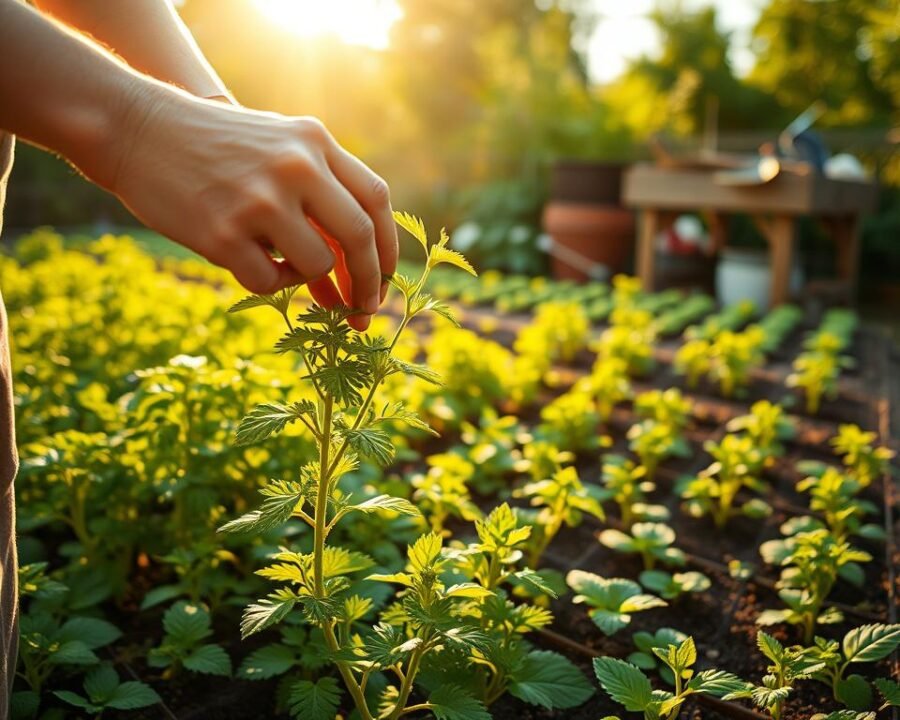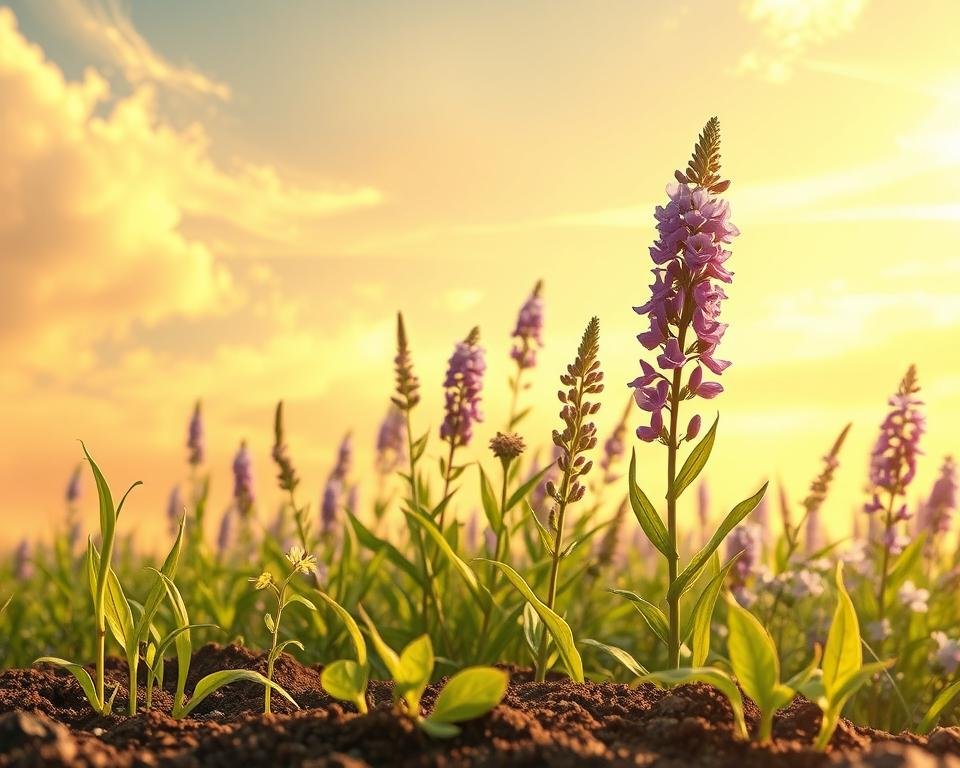There’s something magical about nurturing a dream herb. Whether it’s the silvery leaves of Mugwort or the vibrant blossoms of Calea Zacatechichi, these botanicals carry centuries of mystique. Many gardeners and wellness seekers are drawn to their dual charm—practical beauty and dream-enhancing properties.
From ancient rituals to modern gardens, these plants bridge tradition and curiosity. Some varieties, like Silene Capensis, even hold cultural significance. Others thrive as resilient additions to any garden, blending aesthetics with purpose.
Our guide simplifies the journey. We’ll explore ideal conditions, care tips, and troubleshooting—so your dream herb flourishes. Whether you’re a seasoned grower or a curious beginner, let’s unlock the potential of these extraordinary plants together.
Key Takeaways
- Dream herbs blend gardening with cultural and wellness benefits.
- Popular varieties include Mugwort, Calea Zacatechichi, and Silene Capensis.
- They thrive with proper light, soil, and care.
- Ideal for both beginners and experienced gardeners.
- Enhances garden aesthetics while supporting dream exploration.
Introduction to Dream Herb
Steeped in tradition, these herbs bridge ancient wisdom and modern curiosity. The Chontal people of Mexico revered Calea Zacatechichi for visionary dreams, while Xhosa shamans used Silene Capensis (African Dream Root) for spiritual initiation. Today, their effects extend beyond rituals—supporting lucid dreaming and calming anxiety.
| Herb | Key Traits | Primary Use |
|---|---|---|
| Mugwort | Silvery leaves, earthy aroma | Dream recall, culinary |
| Calea Zacatechichi | Bitter taste, yellow flowers | Lucid dreaming |
| Silene Capensis | White blooms, tuberous roots | Spiritual journeys |
“These plants are keys to unlocking the subconscious—a gift from ancestors.”
While some, like Mugwort, flavor dishes, others offer psychoactive properties. Pair them with Passion Flower or Valerian Root for enhanced relaxation. Their flowers and foliage add beauty, but their true power lies in transformation—both in gardens and minds.
Choosing the Perfect Location
The right spot can make or break your gardening success. Whether you’re cultivating Mugwort or Calea Zacatechichi, light and space dictate their vitality. Let’s explore how to match their needs with your garden or home setup.
Sunlight Requirements
These botanicals crave 6–8 hours of direct sunlight daily. South-facing windows or open yards work best. Observe microclimates—spots near walls may reflect heat, while shaded areas slow growth.
“Light is their lifeline; without it, even the hardiest varieties struggle.”
Outdoor vs. Container Growing
Container planting offers control. Move pots to chase the sun or shield them from frost. Outdoors, ensure well-draining soil and mulch for root protection. Temperatures between 60–75°F suit most growth phases.
- Balcony gardens: Ideal for urban growers; use lightweight pots.
- Backyard beds: Perfect for perennial varieties—just add frost cloth in winter.
Preparing the Soil for Success
Healthy soil is the foundation of thriving botanicals. For robust growth, focus on texture, pH, and nutrients. The right mix ensures strong roots and resilience against pests or drought.
Ideal Soil pH and Type
Aim for a pH between 6.0–7.5. Slightly acidic to neutral balances nutrient uptake. Test with a home kit—just mix soil with water and check the color strip.
Loamy soil works best. It drains well yet retains moisture. Heavy clay? Add sand or perlite. Sandy soil? Blend in compost to boost fertility.
“Soil isn’t just dirt—it’s a living ecosystem. Treat it right, and your plants will thank you.”
Enhancing Soil Fertility
Organic matter is key. Mix in compost, aged manure, or leaf mold. These feed microbes that help roots absorb nutrients.
- Container blends: Combine peat moss, perlite, and worm castings.
- Mycorrhizal fungi: Sprinkle spores to strengthen root networks.
- Drainage fixes: Layer gravel at pot bottoms for heavy soils.
For seeds, plant at a depth of 1/4 inch. Cover lightly to protect from birds while allowing sunlight to trigger germination. Keep soil moist but not soggy—water gently to avoid displacing seeds.
Planting Your Dream Herb
Proper planting techniques set the stage for vibrant growth. Whether starting from seeds or cuttings, attention to detail ensures healthy roots and lush foliage. Let’s break down the essentials.
Seed Planting Depth and Spacing
Plant seeds 1/4 inch deep in loose soil. This shallow depth lets sunlight trigger germination. Space seedlings 12–18 inches apart to avoid crowding.
For faster sprouting, try scarification:
- Gently rub seeds with sandpaper to thin the outer coat.
- Soak in warm water for 24 hours before planting.
“Patience pays off—germination can take 2–4 weeks at 70°F.”
Using Cuttings for Propagation
Snip 4–6-inch stems from healthy plants. Dip the ends in rooting hormone to speed up development. Plant them in peat pellets or a seed tray with drainage holes.
Boost success with DIY humidity domes:
- Cover cuttings with plastic bottles (cut in half).
- Mist daily to maintain moisture.
For best results, keep soil warm (70–75°F) and bright but indirect light. Roots typically form in 3–6 weeks.
Watering Requirements for Healthy Growth
Balancing moisture is key to keeping these botanicals thriving. Check the top inch of soil—if it’s dry, it’s time to water. Consistency matters more than quantity.
Spotting Watering Issues
Yellow leaves often signal overhydration. Soggy soil suffocates roots, inviting diseases. Conversely, wilting means thirst—rehydrate before stems crisp.
“Plants whisper their needs. Learn their language, and you’ll rarely lose one.”
Smart Drainage Solutions
Prevent waterlogging with these steps:
- Use pots with holes and saucers to control runoff.
- Mix perlite into soil for faster drainage.
- Elevate garden beds with gravel layers.
For precision, try moisture meters. They’re affordable and eliminate guesswork. Self-watering containers also help busy gardeners maintain ideal conditions.
Fertilizing for Robust Growth
Nutrition plays a vital role in unlocking your plant’s full potential. The right blend fuels growth, enhances resilience, and maximizes yields. Let’s explore how to nourish your botanicals the smart way.

Best Fertilizer Types
Balanced NPK (10-10-10) works well for monthly feedings. Organic growers prefer fish emulsion—it’s gentle and rich in micronutrients. For quick fixes, foliar sprays deliver nutrients directly to leaves.
“Think of fertilizer as a vitamin boost. Too little stunts growth; too much burns roots.”
Fertilizing Schedule
Adjust nutrients with the seasons:
- Spring/summer: Apply every 4–6 weeks during active growth.
- Fall/winter: Reduce to every 8–10 weeks for dormant plants.
- Nitrogen deficiency? Yellow leaves signal it’s time for a boost.
For containers, use half-strength doses to prevent salt buildup. Brew compost tea for a natural, nutrient-packed alternative. Your plants will reward you with vibrant results.
Pruning and Shaping Your Plant
Strategic cuts transform ordinary plants into thriving masterpieces. Proper pruning strengthens stems, prevents disease, and encourages lush flowers. With the right techniques, you’ll craft a plant that’s as healthy as it is beautiful.
When and How to Prune
Early spring or late summer is ideal for most varieties. Remove up to one-third of stems to avoid shock. For precision:
- Use sharp shears to cut at a 45° angle.
- Target dead or crossing branches first.
- Pinch tips to promote lateral growth.
“Pruning is like giving your plant a roadmap—it directs energy where it’s needed most.”
| Plant Type | Pruning Time | Key Action |
|---|---|---|
| Perennials | Early spring | Cut back 6 inches |
| Shrubs | Late summer | Thin crowded leaf clusters |
Encouraging Bushier Growth
Shape plants creatively with these methods:
- Espalier training: Train stems along trellises for space-saving elegance.
- Topiary: Trim into geometric forms for ornamental flair.
- Lunar cycles: Prune during waxing moons for vigorous regrowth.
Save cuttings for propagation—each snip can start a new plant. For advanced pruning techniques, explore structured guides.
Ongoing Care and Monitoring
Consistent care keeps your botanicals thriving season after season. Regular checks help spot early signs of stress or infestation. A little attention goes a long way in maintaining vibrant plants.

Pest and Disease Prevention
Spider mites and mealybugs love tender foliage. Inspect leaves weekly, especially undersides. For organic control, neem oil or insecticidal soap works wonders.
“An ounce of prevention is worth a pound of cure—especially in the garden.”
Integrated Pest Management (IPM) combines strategies:
- Beneficial nematodes: These microscopic allies combat soil-dwelling pests.
- Companion rotation: Swap basil for marigolds annually to disrupt pest cycles.
- Early intervention: Isolate affected plants to halt diseases from spreading.
Adjusting Care Through Growth Stages
Seedlings need gentle misting; mature plants crave deep watering. Light requirements shift too—propagate cuttings under grow lights in winter.
| Stage | Water | Light |
|---|---|---|
| Germination | Keep moist | Indirect |
| Mature | Deep, weekly | Full sun |
Track changes with a growth calendar. Note pruning dates and fertilizer applications. Adapt routines as your botanicals evolve.
Propagating Your Dream Herb
Expanding your collection starts with mastering propagation. Whether you prefer starting from seeds or nurturing cuttings, each method offers unique advantages. Let’s explore the best techniques to multiply your botanicals successfully.
Seed Propagation Techniques
Germination takes patience—typically 7–14 days. For best results, surface-sow seeds on lightly moist soil. Avoid burying them deeply; sunlight triggers sprouting.
Some varieties benefit from stratification:
- Chill seeds in the fridge for 2–4 weeks before planting.
- Use peat-perlite mixes to prevent damping-off disease.
- Maintain 70°F and high humidity for consistent sprouting.
“Every seed holds potential. Give it the right start, and it’ll reward you tenfold.”
Cutting Propagation Methods
Cloning preserves desirable traits from healthy mother plants. Snip 4-inch stems, dip in rooting hormone, and plant in a peat-perlite blend. Roots usually form in 2–3 weeks.
| Method | Success Rate | Key Tip |
|---|---|---|
| Water Propagation | 75% | Change water weekly |
| Soil Propagation | 85% | Use humidity domes |
For advanced growers, air layering works well. Wrap moist sphagnum moss around scored branches until roots develop. Track progress in a propagation log—note dates, methods, and success rates.
Need detailed guidance? Explore step-by-step cutting techniques for optimal results.
Understanding the Lifecycle of Dream Herb
Watching these botanicals evolve reveals nature’s perfect timing. Their growth cycles blend predictability with subtle surprises. Whether annual or perennial, each phase offers unique beauty and challenges.

Annual vs. Perennial Growth
Some varieties, like Calea Zacatechichi, complete their journey in 3–4 months. Others, such as Mugwort, return yearly in USDA zones 9–11. Perennials need winter mulch for root protection.
“A perennial’s resilience mirrors its storied past—rooted deep, rising again.”
Key Growth Stages
Five phases define their growth:
- Germination (1–3 weeks): Tiny sprouts emerge with delicate leaves.
- Vegetative: Rapid stem and leaf development.
- Budding: First signs of flowers or seed heads.
- Maturity: Peak aroma and potency.
- Dormancy/Seed-set: Energy shifts to roots or seeds.
| Stage | Duration | Care Focus |
|---|---|---|
| Germination | 2–4 weeks | Keep soil moist |
| Flowering | 3–6 weeks | Increase phosphorus |
Track milestones with photos—compare growth in different climates. Harvest leaves just before flowers open for peak potency. Save seeds by drying seed heads fully.
Benefits of Growing Dream Herb
Beyond their mystical allure, these botanicals enrich daily life in surprising ways. The dream herb offers more than vivid dreams—it’s a versatile ally in kitchens, crafts, and cultural practices. Whether harvested fresh or dried, its effects ripple through multiple dimensions of wellness.
Aromatic and Culinary Uses
Antioxidant-rich leaves elevate both health and flavor. Incorporate them into:
- Signature teas: Blend with mint or chamomile for relaxing infusions
- Dream pillows: Stuff dried leaves into linen sachets for bedtime aromatherapy
- Seasoning blends: Crush leaves with sea salt for unique umami notes
“The first sip of Calea tea transports you—earthy, bitter, yet strangely comforting.”
Pollinator-friendly flowers attract bees and butterflies, boosting garden biodiversity. Harvest at peak quality by picking leaves mid-morning after dew evaporates.
Cultural and Spiritual Significance
These plants bridge generations through shared rituals. Modern adaptations include:
- Storytelling circles: Host gatherings where participants share dreams over herbal tea
- Journaling prompts: Document nighttime journeys alongside moon phase observations
- Smudge ceremonies: Bundle stems with sage for energy-cleaning traditions
The dream herb offers tangible connections to ancestral wisdom. Its effects on consciousness have been celebrated from Oaxacan villages to urban apothecaries. Try steeping leaves with honey to soften their bold flavor during meditation sessions.
Troubleshooting Common Problems
Even the healthiest plants face challenges—spotting issues early keeps them thriving. Wilting, spots, or nibbled edges signal trouble. We’ll tackle watering mistakes, pests, and diseases before they escalate.
Identifying and Fixing Watering Issues
Soggy soil causes root rot. Check for mushy leaf bases or foul smells. Let soil dry between waterings. For containers, ensure drainage holes aren’t blocked.
“Overwatering drowns roots; underwatering starves them. Balance is everything.”
- Nutrient lockout: Flush soil with pH-balanced water if salts crust the surface.
- Self-watering spikes: Ideal for consistent moisture in hot climates.
Dealing with Pests and Diseases
Animals like deer and rabbits love tender shoots. Deter them with chicken wire cloches or homemade pepper spray (1 tbsp cayenne + 1 quart water).
| Issue | Solution | Prevention |
|---|---|---|
| Powdery mildew | Spray leaf with baking soda mix (1 tsp soda + 1 quart water) | Space plants for airflow |
| Aphids | Blast with water or apply neem oil | Introduce ladybugs |
Rotate crops yearly to disrupt pest cycles. For fungal diseases, remove infected leaves and avoid overhead watering. Healthy plants resist common problems better—focus on soil and sunlight first.
Conclusion
From seedling to harvest, each phase brings its own magic. Our journey with these botanicals blends patience and discovery. Whether you’re tending a dream herb garden or exploring their cultural roots, every step offers rewards.
Celebrate milestones—first sprouts, vibrant flowers, and successful harvests. Share your results with fellow growers. Together, we deepen our understanding of these enchanting plants.
Consider turning passion into purpose. Small-scale herb businesses thrive on quality and care. Start with seasonal checks: mulch in winter, prune in spring, and rotate plantings yearly.
Keep learning. Experiment with new varieties or propagation methods. The dream herb garden evolves, and so do we. Happy growing!
